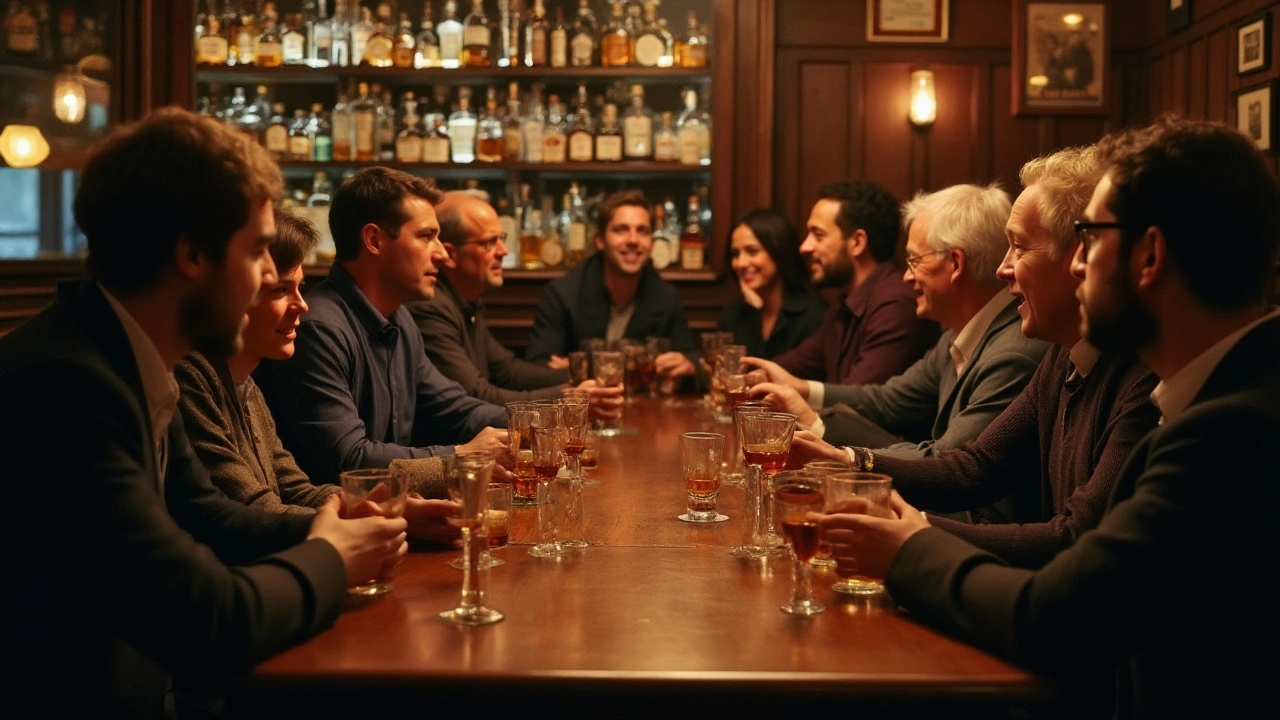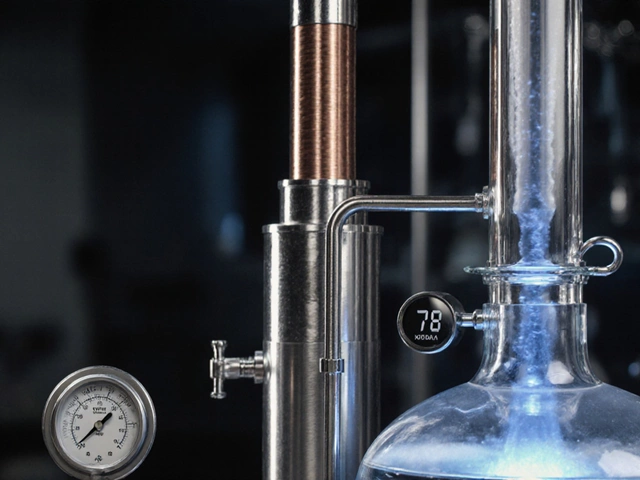Few liquors spark such spirited discussions as whiskey, particularly when it comes to the best way to enjoy this age-old spirit. Whether you're a veteran connoisseur or new to the world of whiskey, the method in which it's consumed can profoundly alter the experience. One of the most timeless debates circles around the idea of drinking it neat—straight from the bottle to the glass, with no additions.
Drinking whiskey neat is cherished by purists who revel in experiencing the spirit in its most unadulterated form. They savor each sip as it showcases the distiller's craft, reflecting years of tradition and meticulous care. Yet, others argue that incorporating a drop of water or a cube of ice can unveil nuanced flavors otherwise masked by the strong alcoholic content. In this article, we embark on a journey through taste and tradition, offering insights and guidance on how to best enjoy whiskey, whether pure or with a twist.
- The Tradition of Drinking Whiskey Neat
- Exploring the Flavor Profile Neat
- Adding Water: A Gateway to Hidden Notes
- The Ice Controversy: Cold vs. Warm Whiskey
- Tools and Glassware for Neat Enjoyment
- Enhancing the Experience with Food Pairings
The Tradition of Drinking Whiskey Neat
Drinking whiskey neat is not just a preference; it's a practice that traces back centuries, entwined with heritage and lore. In the world of whiskey aficionados, sipping neat is akin to unlocking a liquid time capsule, where each bottle narrates stories of its origin. Before commercialization turned whiskey into a globetrotter, distillers and drinkers shared a common understanding—whiskey was a craft best appreciated in its raw form. This tradition stemmed from the desire to savor the pure essence of the spirit, unmasked by mixers or chilling factors.
The Scottish Highlands, renowned for their rugged beauty and centuries-old distilling practices, serve as a prime example of where neat whiskey drinking is steeped in tradition. Here, distillers emphasize the importance of appreciating the nuance of their craft, best experienced when whiskey is untainted. Not just a preference but a cultural statement, drinking whiskey neat can be seen as a means of connecting with the craftsmanship and the land itself. Neat whiskey allows the drinker to explore the entirety of the whiskey's flavor profile, including the grain, the wood, and the subtle changes brought by aging.
To quote whiskey writer Michael Jackson, "When you sip it neat, you embark on a journey that captures the soul of the spirit. Anything added detracts from that journey and disturbs the story it has to tell."
In Ireland, another epicenter of whiskey culture, the emphasis on neat consumption is just as profound. Whiskey here is not just a drink but a heartening presence at gatherings, complementing stories shared among friends and families. Beyond flavor, drinking neat for many Irish represents embracing history and fostering connections, much like their ancestors did in simpler times. They find warmth in knowing that the whiskey neat in their hand is a gesture of homage to time-honored traditions.
The tradition of drinking whiskey neat persists because of this deep-rooted appreciation for the intricate layers of flavor artfully developed during distillation and aging. By holding a glass of neat whiskey, one imagines being part of an unbroken lineage of enthusiasts who each made their own pilgrimage into this realm of taste. While modern methods and mixology might tempt with variety, there remains something compelling about returning to the basics with a neat pour. For those willing to explore this traditional path, the rewards are manifold and deeply enriching to the experience.
Exploring the Flavor Profile Neat
There's an incomparable joy in sipping a whiskey neat, where the spirit's true essence is allowed to shine. When enjoyed straight, the whiskey can offer a cornucopia of flavors, each nuanced and unique, brought forth by the meticulous combination of grain, water, yeast, and aging. The absence of any dilution means that both the strengths and subtleties of the whiskey stand in full view, revealing a spectrum of aromas and tastes. Seasoned drinkers often revel in this approach, advocating that a neat pour allows one to truly experience the whiskey as the makers intended.
Tracing the whiskey's heritage and craftsmanship through its flavor profile can be likened to reading a story with each note. The vast diversity in whiskey types, such as bourbon, Scotch, or Irish whiskey, introduces drinkers to a variety of flavor bases. For instance, a bourbon, primarily derived from corn, often delivers a sweeter profile with hints of vanilla and caramel. The influence of the charred oak barrels adds complex notes of woody spice that elegantly complement these inherent sweet flavors. On the other hand, a classic Scotch might present a robust smoky aroma—a characteristic trait attained during its malting process with peat smoke.
Enjoying whiskey neat also encourages one to become familiar with the spirit's body and texture. A sip of this golden liquid can start with a burst of flavor that gradually evolves, sending waves of warmth down the throat. Some enthusiasts recommend gently swirling the glass to release the aromatics trapped under the rim, a practice known as ‘nosing.’ This olfactory experience often uncovers hidden notes that might not register on the palate initially.
"A whiskey's taste is not just about what meets the tongue, but also what the nose and mind can perceive," famed whiskey connoisseur Richard Paterson once remarked. Through careful and attentive tasting, individuals can discern an intricate dance of flavors, from the tang of citrus to the earthy undertones of leather and tobacco.
For those savoring the experience, recording tasting notes can be enlightening. It serves as both a reference and a journal of a drinker's evolving palate. With time and practice, one might begin to detect the impact of elements such as the region of production, the age of the whiskey, and even the distillation methods. These factors contribute significantly to a whiskey's complexity and character, making each tasting session a learning experience. A neat pour, free of extraneous influences, allows you to engage directly with these countless intricacies. It becomes a personal discovery as no two palates are the same, and each individual may highlight different aspects of the whiskey.

Adding Water: A Gateway to Hidden Notes
Many avid whiskey tasting aficionados might raise an eyebrow at the thought of diluting their prized pour with water. Yet, this practice holds centuries of tradition and science behind it. The addition of just a few drops of water, frankly, does something magical to whiskey. Imagine the spirit as a tightly bound book with a wealth of stories within, but it needs just the right key to reveal its hidden depths.
Water can act as this key, lowering the alcohol content and opening up complex flavor profiles previously masked by the high alcohol potency. This process is often called 'releasing the serpent,' as the fierce spirit becomes more approachable, akin to taming a wild beast. When you add water, you may notice an enhanced sweetness or distinct notes of fruit, smoke, or spice that weren't as pronounced before. This phenomenon is backed by chemistry: water breaks the surface tension and releases aromatic compounds hidden beneath the high-proof veil of whiskey.
A well-known industry figure, whisky researcher Mikael Mossberg, once remarked, "Water unlocks the doors to a whiskey's soul. In just a drop or two lies the potential to transform the drinker's experience entirely."
Experimentation is key when it comes to finding your personal preference. The whiskey drinking process is incredibly subjective, and the ideal dilution can vary from one whiskey to the next. Some whiskies might flourish with a touch more water, while others might only need a whisper. Experienced tasters often keep a small pipette nearby, allowing for precision in their exploration.
It’s also essential to consider the type of water used. Purists may prefer bottled spring water, as it mirrors the natural sources surrounding distilleries, while urban dwellers may opt for filtered water to avoid chlorination and mineral distortions. Distillers often use the same water that flows through their home region, providing a subtle nod to the terroir of a specific whiskey.
Flavors can transform dramatically with just a few drops. A peaty Scotch may unveil an unexpected floral note, while a rye might mellow to reveal creamy, caramel traits. To truly notice these subtleties, take a moment to savor and enjoy the journey that each sip offers. Remember to give your olfactory senses a workout, as the fragrance released by the water adds another dimension to this delightful experience.
| Whiskey Type | Recommended Water Ratio |
|---|---|
| Bourbon | 5:1 |
| Single Malt Scotch | 10:1 |
| Rye Whiskey | 6:1 |
As you explore the realm of adding water to whiskey, it's crucial to trust your palate. After all, the joy of whiskey experience comes from embracing one's own taste journey. So, next time you pour a dram, don't hesitate to have that dropper at hand—because in these nuances lie the essence of whiskey enjoyment.
The Ice Controversy: Cold vs. Warm Whiskey
When it comes to enjoying whiskey, the debate over whether to serve it cold or warm is a topic of endless fascination and lively discussion. The roots of this debate lie deep within the very essence of whiskey drinking tips and the sensory experience it provides. On one side of the spectrum, some enthusiasts argue that whiskey should be sipped at room temperature to truly appreciate its full bouquet of flavors and aromas. They believe that chilling the whiskey can numb the palate, potentially masking the delicate notes that distillers have painstakingly crafted into each bottle. This viewpoint is often championed by seasoned aficionados who relish the warmth and complexity that comes with each neat sip.
Conversely, there's a growing faction of whiskey lovers who embrace a cooler approach, savoring their preferred spirit over ice. The rationale here is that a touch of cold can smooth out the sometimes jarring heat of high-proof whiskies, making them more approachable for those who might otherwise find them too intense. A cold whiskey can also be quite refreshing, particularly in warmer climates or during the summer months, and allows for a leisurely sip without the drink becoming too quickly overwhelming. This method has gained popularity, especially among newer whiskey drinkers or those seeking a novel twist on traditional consumption.
Ice can also be an effective tool in unlocking new flavors, as it gradually melts and dilutes the alcohol, revealing subtler characteristics much like adding a splash of water. There's a prevailing notion that whiskey served over ice is simpler to navigate, allowing newbies to gradually acquaint themselves with the spirit's depth before moving on to appreciate it in its unaltered state. However, one must be cautious not to let the ice over-dilute, which could potentially wash away the whiskey's intended profile—a balance easily tipped if the ice melts too fast.
Some industry experts weigh in on this debate with a balanced perspective. Renowned whiskey expert Michael Jackson once said, "In the end, the best way to drink whiskey is the way that brings you the most pleasure. The choice between cold and warm whiskey is less about right or wrong, and more about personal preference." Such insights remind us that while there are traditional methods, personal enjoyment should be at the forefront of any whiskey experience. For those seeking variety, there are even special 'whiskey stones' available, designed to chill the drink without the dilution that comes with melting ice.
Interestingly, a study conducted in 2022 revealed that 60% of whiskey drinkers aged 25-40 preferred to enjoy their whiskey with ice, suggesting a shift in modern drinking habits that reflects a blend of comfort and curiosity. To visualize this, consider the following table which outlines preferences based on age group:
| Age Group | Preference: Neat | Preference: Ice |
|---|---|---|
| 18-24 | 30% | 70% |
| 25-40 | 40% | 60% |
| 41-55 | 50% | 50% |
| 56+ | 65% | 35% |
Such statistics highlight the evolving nature of whiskey culture and encourage us to appreciate the diverse ways whiskey can be enjoyed. Whether neat or with ice, the most important element remains the enjoyment and appreciation of the unique experience whiskey offers.

Tools and Glassware for Neat Enjoyment
Drinking whiskey neat is a different experience than mixing it with other ingredients or cooling it with ice. It deserves its own set of tools and glassware, specially designed to enhance the nuanced flavors and aromas that each sip offers. The Glencairn glass is possibly the most renowned piece in a whiskey drinker’s arsenal. Its unique tulip shape is both aesthetically pleasing and practical, designed to concentrate the intricate aromas towards the nose, elevating the olfactory experience. This shape also allows for a gentle swirl, aiding in the aeration of the whiskey, which can bring out subtle flavor notes hidden in the glass.
Whiskey aficionados might also consider using a traditional nosing glass. Similar to the Glencairn, these glasses often have a slightly longer stem, which prevents the heat of your hand from affecting the liquid’s temperature. The subtle warmth can alter the chemical makeup, thus changing the flavor. Some purists even suggest using silver whiskey tumblers, a nod to tradition. Way back, these were among the few available tools, used to slowly savor only the finest of spirits during celebrations and special occasions.
Another essential tool is a whiskey decanter. Though often relegated to decorative purposes in contemporary times, a quality decanter serves the purpose of allowing the whiskey to breathe, potentially mellowing sharp alcohol notes with added aeration. However, it is crucial to ensure the seal is tight, as prolonged exposure to air can degrade the spirit’s complex profile. The addition of a whiskey stone, often made from granite or soapstone, provides an opportunity to cool the whiskey without the dilution offered by ice. This ensures the whiskey tasting experience remains unadulterated, just as intended.
"The right glass can transform a simple pour into an exceptional experience," says whiskey expert and writer David Broom. "It's about bridging the gap between the spirit and the senses."
The art of tasting also involves the use of a tasting cloth or mat, an unassuming yet valuable tool to keep things organized and neat, especially when arranging a tasting session with multiple spirits. These mats can guide a taster’s journey, ensuring each spirit's unique traits are noted, compared, and remembered. No matter the choice of glassware or tools, the central goal remains the same: to honor the whiskey experience, celebrating the intricacy and craftsmanship found within each bottle. Investing in the right gear enriches this ritual, turning a potentially fleeting moment into a cherished memory.
Enhancing the Experience with Food Pairings
Pairing whiskey with food can transform a simple tasting into an elaborate and satisfying feast for the senses. Much like wine, whiskey tasting is enriched when complemented with carefully selected morsels that enhance its distinct flavors and textures. The bold and layered profile of whiskey offers an array of pairing possibilities that suit different palates and seasons. From the spicy warmth of rye to the smooth sweetness of bourbon, each type of whiskey can shine alongside culinary creations that balance or amplify its essence.
Consider starting your pairing journey with cheese. The creamy richness of a quality blue cheese can beautifully underscore the caramel notes of a well-aged bourbon. Manchego, with its nutty, slightly tangy profile, pairs wonderfully with the sharp spice of rye whiskey, creating a delightful contrast on the palate. With Scotch whiskies, a smoked Gouda or an aged cheddar can resonate with the smokiness or peatiness that characterizes many of these spirits.
Don't shy away from exploring more unexpected pairings, too. Chocolate, particularly dark chocolate with a high cocoa percentage, melds with whiskey's complex layers, enhancing each sip's depth. Dried fruits like apricots or figs can also complement a swift malt whiskey, offering a sweet balance to its dry finish. Consider crafting a charcuterie board where cured meats like salami or prosciutto meet tangy pickles and olives. The saltiness of these meats often brings forward the sweetness in bourbon or highlights the vanilla tones in certain American whiskies.
To derive full enjoyment from these pairings, it's crucial to think about whiskey as a complete tasting experience where aroma, flavor, and even texture play roles. Start with delicate flavors and progressively work towards stronger ones. This method prevents the overpowering of palate nuances, allowing for better appreciation of the distinct whiskey experience. John Hansell, a whiskey expert, once remarked,
"Food and whiskey should converse, never arguing nor one shouting over the other."His words emphasize the harmony required in pairing.
If you're in the mood to play with temperatures, consider warm desserts like bread pudding or pecan pie to match the fervent bite of a high-proof whiskey. The sweet, gooey nature of these treats can temper alcohol's fiery edge, generating an inviting warmth ideal for leisurely evenings. Conversely, a refreshing scoop of sorbet could provide a brisk counterbalance to a deeply rich and peaty dram. When opting for savory dishes, spicier cuisines such as Indian or Mexican food can marry astonishingly well with bold bourbons or rye.
An experimental approach can be just as rewarding, too. Host a dinner party centered around a tasting menu where each course is paired with a different style of whiskey. Keep in mind that personal taste is subjective, and sometimes breaking conventional pairings leads to the most delightful discoveries. In this fusion of flavors and aromas, whiskey's vast dimensions become a boundless canvas for culinary creativity. Whether you uncover new favorite combinations or enjoy classic pairings, your journey through whiskey and food is bound to be memorable.


